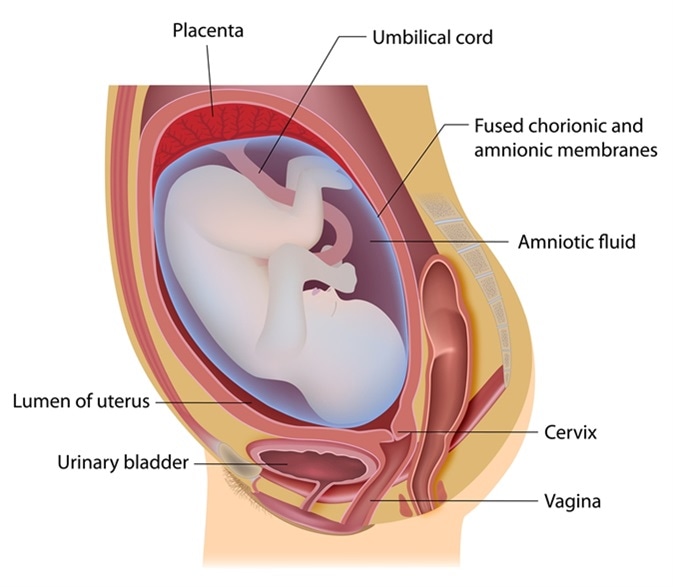
What is Amniotic Fluid?
Written by Lois Zoppi, BA, reviewed by Sophie Mullany, BSc
Amniotic fluid fills the amniotic sac, a bag inside a woman’s uterus (womb) where an unborn baby will develop. The sac provides protection and a constant temperature for the baby to grow in, as well as giving the baby fluids so it can breathe, swallow and develop its muscoskeletal system.
It is sometimes referred to as the membranes, as the sac is made of two membranes; the amnion and the chorion. There are several infections and complications that the amniotic sac is vulnerable to during pregnancy and birth.

Image Credit: Alila Medical Media / Shutterstock
What is it Made of?
Within days of conception, the amniotic sac will form and fill with fluid. At the beginning the fluid mainly consists of water, but the baby will pass small amounts of urine into the fluid from around 10 weeks of pregnancy. The fluid is a clear, pale-straw color.
Where Does it Go?
Either before or during labor, the amniotic sac will break, and the amniotic fluid will drain through the vagina, either gradually or in a sudden rush. This process is commonly known as when one’s ‘waters break’. The risk of infection increases after the amniotic sac breaks, so medical attention should be sought quickly.
Medical Uses for Amniotic Fluid
A test called amniocentesis is offered to some pregnant women if there is a higher chance that their baby might have a genetic condition such as Down’s syndrome, Edwards’ syndrome or Patau’s syndrome. This test includes taking a small number of cells from the amniotic fluid to test for these conditions. There are some risks associated with this procedure, including:
- Miscarriage
- Infection
- The need to repeat the test at a later date
Because of these factors, amniocentesis is carried out after 15 weeks of pregnancy, as the risk of complications is less after this point.
The volume of amniotic fluid can also be used to predict adverse pregnancy outcomes, but this method’s predictive abilities are disputed.
Complications
There are several complications that can occur concerning the amniotic sac.
Polyhydramnios
Polyhydramnios is where there is too much amniotic fluid around the baby. The symptoms of this are:
- Breathlessness
- Swollen feet
- Heartburn
- Constipation
These symptoms are common problems for many pregnant women and do not always signify polyhydramnios. There is a slightly increased risk of premature birth, problems with the baby’s position or the baby’s umbilical cord.
Oligohydramnios
Oligohydramnios is when there is reduced amniotic fluid around a fetus in the uterus (womb). It can affect the baby’s ability to turn to the correct position for birth or cause umbilical cord compression.
The amount of fluid can be increased by increasing liquid consumption, but positive results are not conclusive and controlled clinical trials are required to definitively assess the clinical benefits and risks to both the mother and the baby.
Amniotic fluid embolism
Amniotic fluid embolism (AFE) is a sudden cardiorespiratory collapse and is a medical emergency. The cause of AFE is not completely understood, but it is estimated that AFE occurs in one case per 8,000-30,000 pregnancies. Its symptoms include:
- Agitation
- Hypotension
- Dyspnea
- Evidence of fetal compromise
- Coagulopathy
- Altered mentation
Risk factors of amniotic fluid embolism
No specific race or ethnicity is thought to be more susceptible to AFE, although one study has suggested a predilection in non-Hispanic black women. There is a suggestion of increased incidence in women of higher maternal age, reported in at least two studies.
Other reported risk factors for AFE are:
- Multiparity
- Male fetus
- Trauma
- Medical induction of labor
- Cesarean section
- Placenta previa
- Cervical laceration
- Uterine rupture
Maternal survival of AFE is uncommon, however successful pregnancies have been reported after pregnancies complicated by AFE. The risk of AFE reoccurrence is currently unknown.
Chorioamnionitis
Chorioamnionitis, or intra-amniotic infection (IAI), is characterized by acute inflammation of the amnion and chorion. This is due to a bacterial infection in the fetal membranes, amniotic fluid and placenta, ascended from the vagina into the uterus. For a newborn baby, it can cause problems such as whole-body inflammation, sepsis, pneumonia and meningitis. It can also present problems for the mother, including pelvic infection, sepsis, postpartum hemorrhage, and an increased risk of caesarean delivery. Risk factors for chorioamnionitis include:
- Prolonged active labor
- Meconium staining of amniotic fluid (dark green liquid passed by a newborn baby containing mucus, bile and epithelial cells)
- Various digital vaginal examinations
Research Amniotic fluid stem cells (AFSCs) are an area of interest for research in regenerative medicine. The possible uses for AFSCs are:
- Tissue reconstruction
- Regeneration of neural tissue
- Cardiac, kidney and lung epithelial regeneration
- Bone and cartilage engineering
The promise of amniotic fluid in regenerative medicine lies in the cell’s inability to form tumors after in vivo implantation. A better understanding of AFSCs is necessary before research progresses to human trials.
Conclusion
Amniotic fluid is produced to help an unborn baby grow its muscoskeletal system and to protect it from injury. Complications concerning the amniotic sac, such as amniotic fluid embolism, are not fully understood due to inconsistent reporting in nonfatal cases and inaccurate initial diagnoses. Complications can also arise from bacterial infections. Promising research is being conducted to investigate how amniotic fluid stem cells can be used in regenerative medicine, and while results so far have been positive, further research is necessary to develop a better understanding for use in human trials.
Sources
- https://www.ncbi.nlm.nih.gov/pmc/articles/PMC3008318/
- https://www.ncbi.nlm.nih.gov/pubmedhealth/PMH0010497/
- https://www.ncbi.nlm.nih.gov/pubmedhealth/PMH0065421/
- https://www.ncbi.nlm.nih.gov/pubmedhealth/PMH0071363/
- www.nhs.uk/common-health-questions/pregnancy/what-is-the-amniotic-sac/
- https://www.nhs.uk/conditions/Amniocentesis/
- https://www.nhs.uk/conditions/polyhydramnios/
Last Updated: Aug 9, 2018





















.jpg)










No hay comentarios:
Publicar un comentario